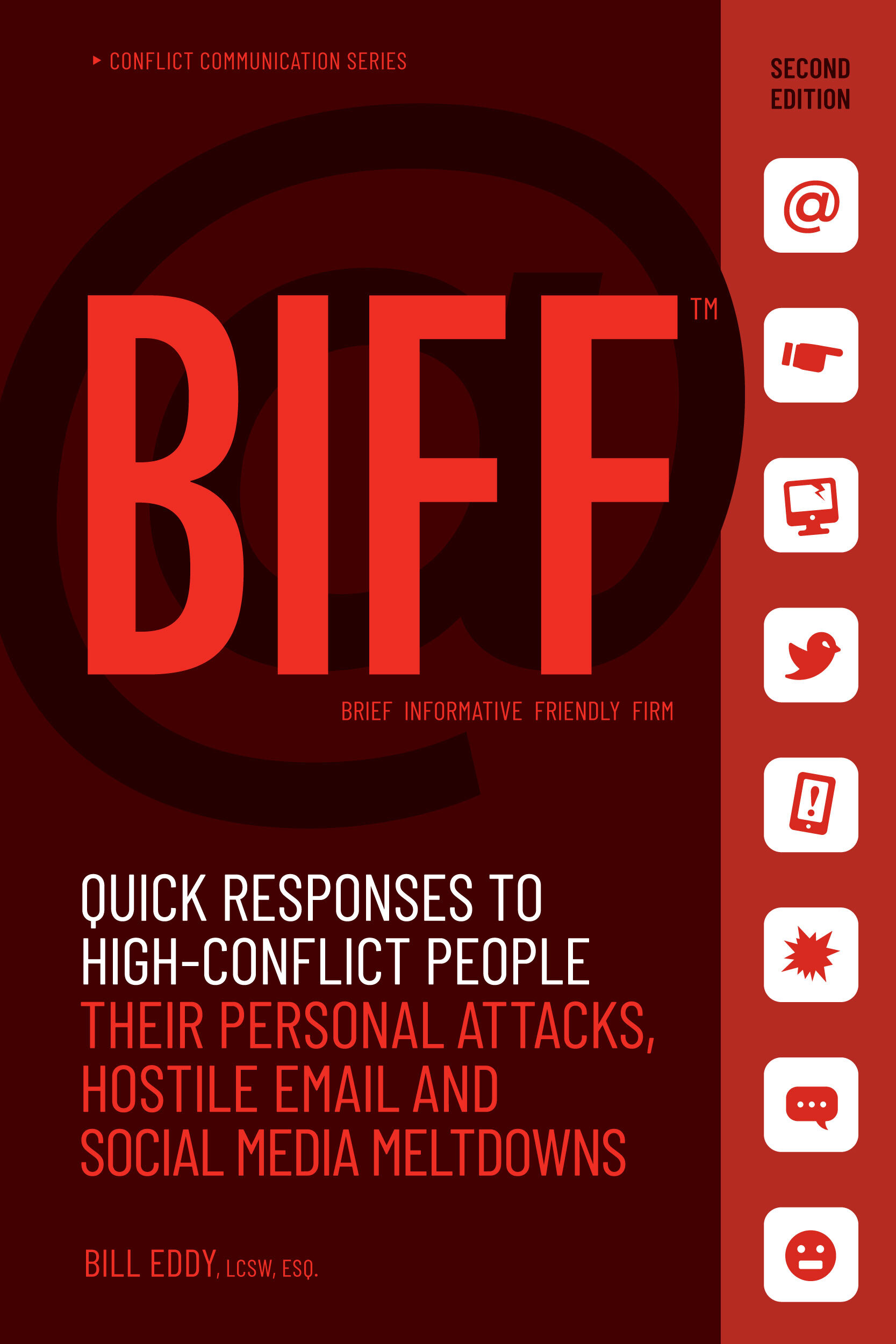How BIFF Response® Was Born
© 2020 By Bill Eddy, LCSW, Esq.
BIFF was born in March 2007 in Phoenix, Arizona, when I was giving a workshop about managing high conflict divorce cases in family courts.
It was the first in a series of trainings that I was doing with Megan Hunter around the United States, the year before we founded High Conflict Institute. There were about 20 lawyers, mediators, therapists, and two judges in attendance that day.
This is how I remember it.
One of the techniques I taught them was EAR Statements™, which is a calm way of responding in person to someone who was upset or angry. I had developed this method a few years earlier when I discovered that my counseling background could help in calming my clients as a lawyer and in mediation sessions.
It made it easy to remember to make statements showing Empathy, Attention and Respect. Since law and mediation clients were often upset and sometimes verbally attacked me, I found that this was an easy way to remember what to do when I was under stress.
As I was giving the training, the class said this was a really useful technique because it was so easy to remember—because they were often under stress too.
Then, at some point in the middle of the March program, one of the judges asked me “What can we do about these awful emails that some of the parents are sending to each other and then filing with the court?…
Each one is pointing the finger at the other one, saying how outrageously the other is behaving. Yet it seems like both of them are acting badly—sometimes equally badly, but they just can’t see it.”
By then, I had been a therapist for a dozen years, followed by 14 years as a family lawyer and mediator. I had had many of those cases with nasty emails and I had been teaching my clients to avoid engaging in them—choosing their battles as to when to respond and when to just ignore them.
I hadn’t really thought much about how I was telling them to write those emails, but when the judge asked the question it got me thinking about what worked and what didn’t work. After all, I had a few hundred cases by then and had seen (and been part of writing) probably a thousand emails and letters in divorce cases.
“Certainly, they need to be brief,” I said to the judges and the rest of the group. “From my experience, the longer the email the more trouble one gets into. From what I’ve seen, a paragraph is usually sufficient, even in response to a several page email or letter.”
Actually, around that time I had written a letter in one of my cases to a child therapist who had no experience with high conflict family law cases. He was making things worse without even realizing why, and he had written a letter which didn’t help.
So I carefully wrote him a 5-page letter in response, explaining how high conflict family law cases worked (because of my therapist and lawyer background) and that what he was doing made things worse—not better.
Rather than getting a “thank you” from him for my tips, I received the brunt of his anger at being told how to do his counseling. I realized that I shouldn’t write long letters in high conflict cases, even to professionals.
“I also think they need to be informative,”
I added to the class. “Just straight information…
No opinions, no emotions, no defensiveness because that’s what escalates things.”
That’s not easy to do
But, I have been coaching my clients on writing that way and they actually feel better doing that. This way they can save time and emotional energy by avoiding all the venting—even when the other person is mostly venting.
“Lastly,” I said. “I think they need to be friendly. Just friendly enough to calm the conversation.
It could be a nice greeting—like ‘Thanks for responding’—or a pleasant closing, like ‘Have a good weekend.’ I try to tell my clients to think of how they would write to a friend. This keeps them from making things worse from their end.”
One of the judges was busy writing this down and looked up and said: “That’s BIF! B-I-F!”
“Hm,” I replied. “I never thought of it that way before.”
“Then you need another ‘F,’ and you have BIFF,”
the other judge said. “Easy to remember, just like EAR.”
I immediately thought that the next most important thing about emails and letters was that they should end the hostile conversation instead of escalating it…
Then, the other ‘F’ would be Firm,”
I said. “You want them to end the hostilities without putting out a hook to get the other person to respond. (No: ‘What do you think of that, Buddy?’) And that can be really hard to do, but so important.
So BIFF would be Brief, Informative, Friendly, and Firm.
Thanks! That makes it easier to remember.”
Everyone was pleased to have it be so simple and it was one of the great take-aways from the training—for me as well as the participants.
Yet I also realized that it wasn’t simple at all and that I sometimes spent half an hour or more helping a client feel confident that their email response wasn’t showing weakness because it didn’t include any hostile remarks like the email they were responding to.
But I also realized that BIFF sounds strong.
Later that year I wrote an article about it called “Responding to Hostile Mail (B.I.F.F).” But at some point I realized that we needed to say more than just “BIFF.” It might have been after a I had a conversation with a man from Australia at a training I gave in Toronto later in 2007.
The training included family lawyers, therapists and mediators, and I told them about BIFF for emails and letters.
Afterward, at the end of the all-day training, a man came up to me and said that he was from Australia and that BIFF already had a common usage there. “In Australia, a BIFF means a ‘faht.’ You might want to think of a different word for Australia.” To be honest, I wasn’t sure (with his accent and my hearing) whether he had said “fart” or “fight.” I was tired, so I simply thanked him and told myself I would need to look it up.
I liked BIFF and didn’t want to change it—
but in 2008 I would be giving my first trainings in Australia.
When I arrived in Melbourne, Australia, I was riding a bus a day or so before giving my first training and a headline jumped out at me from a newspaper another rider was reading. It said something like “Fans Want More BIFF at Games.”
That clinched it: BIFF was a fight between players, with them trying to punch each other. Whew, I was relieved to find out in advance that a BIFF wasn’t a fart!
But did that eliminate my use of the word BIFF for this communication technique? It occurred to me that BIFFs were really responses to verbal punches from people in a high conflict divorce or workplace dispute or other setting. In Australia, I would emphasize that the technique was a BIFF Response, and thus BIFF Response® was born.
Years later Megan and I trademarked the term—in the United States and Australia!
In 2011, I wrote the book
BIFF: Quick Responses to High Conflict People, Their Personal Attacks, Hostile Email and Social Media Meltdowns (updated in 2014 with Coaching for BIFF),
Through the books and our trainings, I estimate that we have taught half a million people how to calm their written conversations with the BIFF Response® method over the past thirteen years.
This year we have a new BIFF book focused exclusively on coparent communication
It goes far beyond the original book by addressing approximately twenty examples of co-parent disputes and sample BIFF Responses, from parenting schedules to healthcare decisions to stepparent involvement.
One of the most exciting things for me is getting feedback from many parents about how writing BIFF communications has calmed the writing of both parents, even when the other one doesn’t know the method! It’s contagious in a good way.
I hope you’ll check it out and let us know how it works for you.
Bill Eddy, LCSW, Esq. is the co-founder and Chief Innovation Officer of the High Conflict Institute in San Diego, California. Read more













